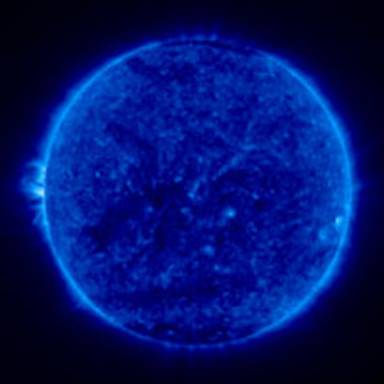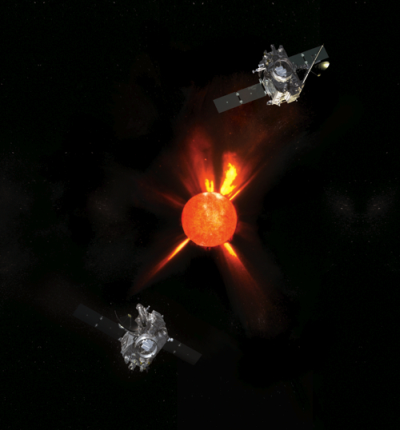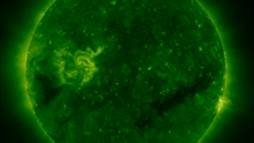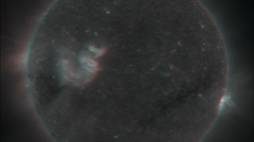25 April 2007

Credit: NASA/STEREO Mission
NASA's twin Solar Terrestrial Relations Observatory (STEREO) spacecrafts have made the first 3-D images of the Sun. The new data will improve solar physics and space weather forecasting.
"The improvement with STEREO's 3-D view is like going from a regular X-ray to a 3-D CAT scan in the medical field," said Michael Kaiser, STEREO's Project Scientist at NASA's Goddard Space Flight Center (GSFC).
The observatories were launched on 25 October 2006. On 21 January 2007, they completed a sequence of complex maneuvers, including lunar flybys, to adjust the space probes' orbits.

The twin STEREO observatories, an artist's rendition
Credit: NASA
The two observatories are now in orbits around the Sun, one slightly preceding Earth and one slightly lagging, receding from each other by approximately 45 degrees per year. Just as the slight offset between a person's eyes provides depth perception, the separation of the twin spacecraft yields 3-D views of the Sun
The new 3-D images are generated by NASA's Jet Propulsion Laboratory (JPL).

2-D image

3-D image
Use 3-D glass for best viewing
Caution: Never attempt to view the Sun directly with the unaided eye or any other optical instrument. Observing the Sun can be performed using special settings and optical instruments.
Violent eruptions in the Sun's outer atmosphere, the solar corona, pervade the entire Solar System, and can damage spacecrafts, disrupt telecommunication, navigation and power grids on Earth. The corona resembles wispy smoke plumes, which flow outward along the Sun's intricate magnetic field.
"In the solar atmosphere, there are no clues to help us judge distance. Everything appears flat in the 2-D plane of the sky. Having a stereo perspective just makes it so much easier," said Russell Howard of the Naval Research Laboratory, Washington, the Principal Investigator for the Sun-Earth Connection Coronal and Heliospheric Investigation telescopes onboard the STEREO spacecrafts.
"With STEREO's 3-D imagery, we'll be able to discern where matter and energy flows in the solar atmosphere much more precisely than with the 2-D views available before. This will really help us understand the complex physics going on," said Howard.
STEREO's 3-D views will help improve predicting solar eruptions, particularly a destructive type, known as Coronal Mass Ejections (CMEs). CMEs are eruptions of plasma, electrically charged gas, from the corona. A CME may contain billions of tons of plasma and move at a million miles per hour.
CMEs have powerful magnetic fields, and those directed towards Earth, slam into our magnetic field. If the CME's magnetic fields are properly oriented, they pour electromagnetic energy and energetic atomic particles into Earth's magnetic field. This gives rise to magnetic storms and radiation storms that disrupt satellites and power networks.
Therefore, an accurate forecast of when a CME will strike is needed. To achieve this, forecasters need to know the location of the front of the CME. STEREO will allow scientists to accurately locate the CME front. "Knowing where the front of the CME cloud is, will improve estimates of the arrival time from within a day or so to just a few hours," said Howard. "STEREO also will help forecasters estimate how severe the resulting magnetic storm will be."
"In addition to the STEREO perspective of solar features, STEREO for the first time will allow imaging of the solar disturbances the entire way from the Sun to the Earth. Presently, scientists are only able to model this region in the dark, from only one picture of solar disturbances leaving the Sun and reaching only a fraction of the Sun-Earth distance," said Madhulika Guhathakurta, the STEREO's Program Scientist at NASA Headquarters, Washington.
STEREO is NASA's third mission in the Solar Terrestrial Probes program of NASA's Science Mission Directorate, Washington. The Goddard Science and Exploration Directorate manages the mission, instruments, and science center. The Johns Hopkins University Applied Physics Laboratory designed and built the spacecraft and is responsible for mission operations. The imaging and particle detection devices were designed and built by scientific institutions in Belgium, France, Germany, the Netherlands, Switzerland, UK, USA.JPL is a division of the California Institute of Technology in Pasadena, California.
Further Reading
STEREO Images
http://www.nasa.gov/mission_pages/stereo/news/stereo3D_press.html .
STEREO Homepage
http://www.nasa.gov/mission_pages/stereo/main/index.html
Aymen Mohamed Ibrahem
Senior Astronomy Specialist